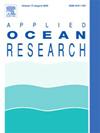Ripple-averaged wave boundary layer over long-crest sand ripples at high Reynolds number: Observations and theoretical model
IF 4.3
2区 工程技术
Q1 ENGINEERING, OCEAN
引用次数: 0
Abstract
Long-crest sand ripples are common bedform features developed by moderate shoaling waves in the coastal environment. The spanwise coherent vortex (SCV) generated in the lee side controls the behavior of ripple-averaged (RA) flow, which is of primary interest to coastal modelers. However, few theoretical model explicitly describes the spatial-averaged flow within the sub-crest region (or ripple sublayer). To close this gap, this study first analyzed some recent high-Reynolds-number experiments with real and fixed ripples in an oscillatory water tunnel. The RA flow has a typical structure of wave boundary layer, i.e., a dominant first harmonic with an overshoot structure. The swirling motion of SCV transfers momentum like the swept and ejection of wall turbulence. The effective stress is most significant within the ripple sublayer, and contains a third harmonic, which is about half of the first harmonic. To model the RA flow, the governing equation is specified by examining the momentum budget. The final form of governing equation is similar to that of conventional oscillatory boundary layer, except for a drag term, which represents the pressure force from the ripple surface. The depth-invariant and time-varying effective viscosity proposed by Davies and Villaret (1997) is adopted, and the drag term is assumed to be linearly proportional to RA velocity. An analytical solution is derived and compared to the measurements. The model can yield satisfactory predictions of the first-harmonic flow. Switching off the drag term will lead to much worse prediction, suggesting the necessity of having it for modeling the sublayer. The model is the basis for further developing models that includes higher-order physics, e.g., wave propagation or wave–current interactions.
求助全文
约1分钟内获得全文
求助全文
来源期刊

Applied Ocean Research
地学-工程:大洋
CiteScore
8.70
自引率
7.00%
发文量
316
审稿时长
59 days
期刊介绍:
The aim of Applied Ocean Research is to encourage the submission of papers that advance the state of knowledge in a range of topics relevant to ocean engineering.
 求助内容:
求助内容: 应助结果提醒方式:
应助结果提醒方式:


